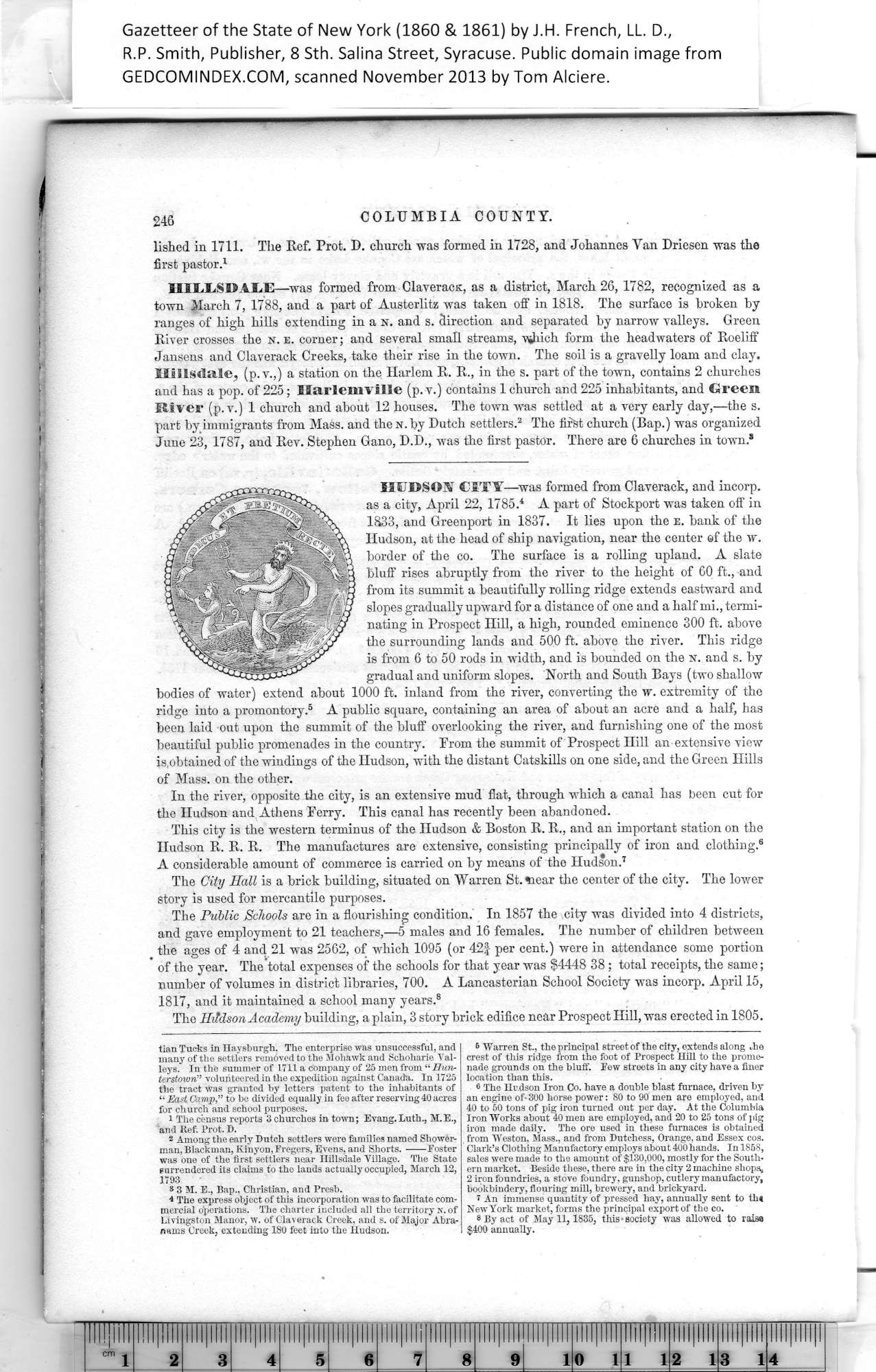|
246 COLUMBIA COUNTY.
lished in 1711. The Ref. Prot. D. church was formed in 1728, and Johannes Van Driesen was the
first pastor.1
HILLSDALE—was formed from ClaveracK, as a district, March 26, 1782, recognized as a
town March 7, 1788, and a part of Austerlitz was taken off in 1818. The surface is broken by
ranges of high hills extending in a n. and s. direction and separated by narrow valleys. Green
River crosses the n. e. corner; and several small streams, which form the headwaters of Roeliff
Jansens and Claverack Creeks, take their rise in the town. The soil is a gravelly loam and clay.
Hillsdale., (p.v.,) a station on the Harlem R. R., in the s. part of the to-wn, contains 2 churches
and has a pop. of 225; Harlemville (p. v.) contains 1 church and 225 inhabitants, and Green
River (p.v.) 1 church and about 12 houses. The town was settled at a very early day,—the s.
part by immigrants from Mass. and the N.by Dutch settlers.2 The first church (Bap.) was organized
June 23, 1787, and Rev. Stephen Gano, D.D., was the first pastor. There are 6 churches in town.8
HUDSON CITY—was formed from Claverack, and incorp.
as a city, April 22, 1785.3 A part of Stockport was taken off in
1833, and Greenport in 1837. It lies upon the e. bank of the
Hudson, at the head of ship navigation, near the center ©f the w.
border of the co. The surface is a rolling upland. A slate
bluff rises abruptly from the river to the height of 60 ft., and
from its summit a beautifully rolling ridge extends eastward and
slopes gradually upward for a distance of one and a half mi., termi¬
nating in Prospect Hill, a high, rounded eminence 300 ft. above
the surrounding lands and 500 ft. above the river. This ridge
is from 6 to 50 rods in width, and is bounded on the n. and s. by
gradual and uniform slopes. North and South Bays (two shallow
bodies of water) extend about 1000 ft. inland from the river, converting the w. extremity of the
ridge into a promontory.4 A public square, containing an area of about an acre and a half, has
been laid out upon the summit of the bluff overlooking the river, and furnishing one of the most
beautiful public promenades in the country. Prom the summit of Prospect Hill an extensive view
is obtained of the windings of the Hudson, with the distant Catskills on one side, and the Green Hills
of Mass. on the other.
In the river, opposite the city, is an extensive mud fiat, through which a canal has been cut for
the Hudson and Athens Perry. This canal has recently been abandoned.
This city is the western terminus of the Hudson & Boston R. R., and an important station on the
Hudson R. R. R. The manufactures are extensive, consisting principally of iron and clothing.5
A considerable amount of commerce is carried on by means of the Hudson.6
The City Hall is a brick building, situated on Warren St. tiear the center of the city. The lower
story is used for mercantile purposes.
The Public Schools are in a flourishing condition. In 1857 the city was divided into 4 districts,
and gave employment to 21 teachers,—5 males and 16 females. The number of children between
the ages of 4 and 21 was 2562, of which 1095 (or 42f per cent.) were in attendance some portion
of the year. The total expenses of the schools for that year was $4448 38; total receipts, the same;
number of volumes in district libraries, 700. A Lancasterian School Society was incorp. April 15,
1817, and it maintained a school many years.8
The Hddson Academy building, a plain, 3 story brick edifice near Prospect Hill, was erected in 1805.
5 Warren St., the principal street of the city, extends along .he
crest of this ridge from the foot of Prospect Hill to the prome¬
nade grounds on the bluff. Few streets in any city have a finer
location than this.
6 The Hudson Iron Co. have a double blast furnace, driven by
an engine of-300 horse power: 80 to 90 men are employed, and
40 to 50 tons of pig iron turned out per day. At the Columbia
Ironworks about 40 men are employed, and 20 to 25 tons of pig
iron made daily. The ore used in these furnaces is obtained
from Weston, Mass., and from Dutchess, Orange, and Essex cos.
Clark’s Clothing Manufactory employs about 400 hands. In 1858,
sales were made to the amount of $130,000, mostly for the South¬
ern market. Beside these, there are in the city 2 machine shops,
2 iron foundries, a stove foundry, gunshop, cutlery manufactory,
bookbindery, flouring mill, brewery, and brickyard.
t An immense quantity of pressed hay, annually sent to th«
New York market, forms the principal export of the co.
8 By act of May 11, 1835, this •society was allowed to raiaa
$400 annually.
1
The census reports 3 churches in town; Evang. Luth., M.E.,
and Ref. Prot. D.
2
Among the early Dutch settlers were families named Shower-
man, Blackman, Kinyon,Eregers, Evens, and Shorts. Foster
waB one of the first settlers near Hillsdale Village. The State
surrendered its claims to the lands actually occupied, March 12,
1793
3
The express object of this incorporation was to facilitate com¬
4
mercial operations. The charter included all the territory N. of
5
Livingston Manor, w. of Claverack Creek, and s. of Major Abra-
6
nams Creek, extending 180 feet into the Hudson.
|
